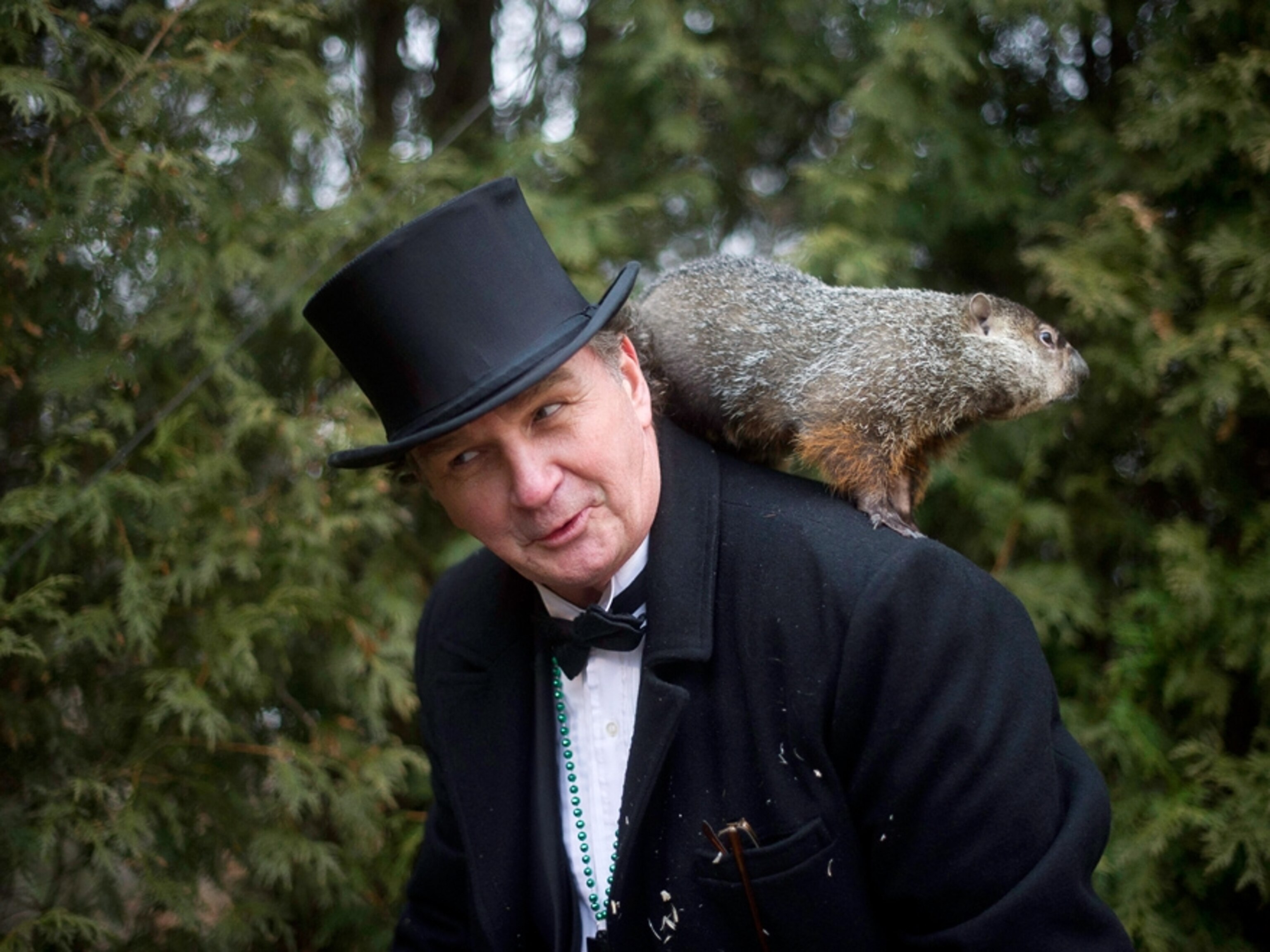
Groundhog Day 2011: Punxsutawney Phil Sees No Shadow
On 125th anniversary, Punxsutawney Phil offers warm greeting.
"The sky is clear. Prepare for warmth!" With those rousing words Wednesday morning, the world's most famous groundhog, Punxsutawney Phil, offered a ray of hope to millions of Americans being buffeted by a monster winter storm. (See Groundhog Day pictures.)
By seeing no shadow as he emerged from his ceremonial burrow in Punxsutawney, Pennsylvania, on Groundhog Day 2011, Phil, according to tradition, is said to have predicted an early spring.
"Groundhog Day is a lot like a rock concert, but the people are better behaved and there's a groundhog involved," Tom Chapin, editor of the Punxsutawney Spirit newspaper, told National Geographic News last Groundhog Day eve.
"There's music and entertainment, spoofs of game shows, and people shooting t-shirts and Beanie Babies" into the crowd, he said.
Legend has it that if Punxsutawney Phil emerges from his temporary burrow—a simulated tree stump at the rural site of Gobbler's Knob—on February 2 and sees his shadow, winter weather will continue for six more weeks across the United States. But if Phil doesn't see his shadow, then spring temperatures are just around the corner.
Regardless of the weather prediction, on Groundhog Day, Phil "speaks" to his human caretakers, known as the Inner Circle, in Groundhogese and tells them his forecast. The Inner Circle then translates Phil's words for the world to hear—or so they say. (Related: "Groundhog Sees More Winter Ahead" [2006].)
On Groundhog Day 2011, "immortal" Punxsutawney Phil—supposedly born no later than the 19th century—got his message out in some decidedly 21st-century ways, by texting his forecast (to sign up, text "groundhog" to 247365) and, of course, updating his Facebook status and the Pennsylvania-tourism Twitter feed.
(Related: "No Winter by 2105? Study Offers Grim Forecast for U.S.")
Video: Wild Groundhog in "Action"
Groundhog Day Origins
According to the official Punxsutawney Phil Groundhog Day Web site, Groundhog Day is the result of a blend of ancient Christian and Roman customs that came together in Germany.
In the early days of Christianity in Europe, clergy would distribute blessed candles to the faithful on February 2 in honor of Candlemas, a holiday celebrating the Virgin Mary's presentation of Jesus at the Temple in Jerusalem 40 days after his birth.
Along the way, February 2 also became associated with weather prediction, perhaps due to its proximity to the pagan Celtic festival of Imbolc—also a time of meteorological superstition—which falls on February 1.
Tradition held that the weather on Candlemas was important: Clear skies meant an extended winter.
Legend has it that the Romans also believed that conditions during the first days of February were good predictors of future weather, but the empire looked to hedgehogs for their forecasts.
These two traditions melded in Germany and were brought over to the United States by German immigrants who settled in Pennsylvania. Lacking hedgehogs, the German settlers substituted native groundhogs in the ritual, and Groundhog Day was born.
(Download a National Geographic groundhog picture as wallpaper.)
Punxsutawney Phil. Will. Not. Die.
In 1887 a group of groundhog hunters from Punxsutawney (map) dubbed themselves the Punxsutawney Groundhog Club and declared their furry oracle, Punxsutawney Phil, the one and only "official" weather-prognosticating groundhog. The Punxsutawney ceremony originated around the same time.
More than a hundred years later, Punxsutawney Phil remains the star of Groundhog Day, though rivals such as Staten Island Chuck and Gen. Beauregard Lee maintain regional fame. (See "Groundhogs Disagree on Winter Prognosis" [2009].)
According to Punxsutawney folklore, Phil owes his long lifespan to an "elixir of life," served every summer at the annual Groundhog Picnic, of which there are curiously no photographs.
Despite the Inner Circle's claims, such longevity would make Punxsutawney Phil a statistical anomaly, to say the least—groundhogs in captivity typically live no longer than about ten years, which suggests Phil's name, passed down like "Lassie," may be the only immortal thing about him. Then again, the current Phil, weighing in at 20 pounds (9 kilograms) versus the usual 13 (6 kilograms), is anything but ordinary.
(Find out why Punxsutawney Phil and other hibernating animals may suffer dangerous wakeup calls due to global warming.)
When he's not predicting the weather, Punxsutawney Phil makes his home at the Groundhog Zoo, an annex of the town library.
Also known as woodchucks, groundhogs are rodents of the marmot genus. Native to most of Canada and the eastern U.S., groundhogs gorge themselves all summer, then hibernate between fall's first frost and the start of spring—with significantly lower heart rates and body temperatures. Seen mainly around fields, streams, and roads, these squirrel cousins feast mainly on grasses and other plants, as well as fruit and tree bark.
Groundhog Day 2011 Predictions: Flipping a Coin More Accurate?
While Phil's proponents maintain that his predictions are 100 percent accurate, the U.S. National Climatic Data Center (NCDC) has estimated that Phil is correct only about 40 percent of the time.
The NCDC reached their conclusion by taking Phil's predictions and comparing them with average temperatures in February and March. In many years when Phil's predicted six more weeks of winter weather, February and March have turned out to be warmer than average.
But to obsess over the accuracy of Phil's predictions is to miss the point, Chapin said. "It's more about having fun."
Groundhog Day Robot to Replace Punxsutawney Phil?
Not everyone finds the annual event entertaining, though.
People for the Ethical Treatment of Animals (PETA) in 2010 sent a letter to the president of the Inner Circle suggesting they retire Phil to a sanctuary and replace him with an electronic groundhog.
"Other popular exhibitions have featured robotic penguins and dolphins who swim and communicate just like real animals do," the letter says, "and we think that an animatronic groundhog would similarly mesmerize a crowd full of curious spectators in Punxsutawney."
Chapin, the Punxsutawney Spirit editor and—journalistic objectivity be damned—an unabashed Punxsutawney Phil fan, dismissed PETA's letter as a publicity stunt.
"The thing about PETA is they only get worried about Punxsutawney Phil once a year," Chapin said. "The other 364 days of the year they don't say anything," he said. "It's an interesting idea, but I don't suspect Phil will be retiring anytime soon."








